
This resource from the New York Times includes a variety of lessons, ideas, and resources to teach students to new vocabulary.
- Provider:
- New York Times
- Author:
- NY Times Learning Network
- Date Added:
- 06/24/2019

This resource from the New York Times includes a variety of lessons, ideas, and resources to teach students to new vocabulary.

In this CCSS lesson, students will explore this story through text dependent questions, academic vocabulary, and writing assignments.

This three-part video demonstrates a lesson plan for teaching vocabulary in context of literature. Part one shows an introductory activity to get students thinking about the words used in the text - in this case, Nathanial Hawthorne's The Scarlet Letter. Parts two and three elaborate and show a small group discussion about the words and the text.
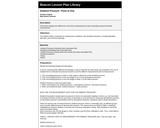
This lesson explains the differences in the three confusing terms used to describe pressure and their measurement.

Students will read three short stories about women, written in different historical periods. Students will read each story and discuss the development of female characters in a particular setting, the role of women, gender differences, and society's expectations.

Students compose epitaphs for deceased characters in "Hamlet," paying close attention to how their words appeal to the senses, create imagery, suggest mood, and set tone. Students will design gravestones to display their epitaphs. Students must capture the essence of their character's personality and station in life.

Students will read, analyze, and discuss Medieval English ballads and then list characteristics of the genre. Then they will examine the narrative characteristics of ballads by choosing a balad to act out. Using the Venn diagram tool, students will compare Medieval ballads with modern ones. Finally, students will compose and perform their own ballads.
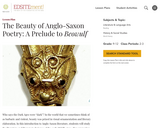
This lesson plan with student activities gives students a preview to reading the Anglo-Saxon epic poem "Beowulf" by reading and understanding riddles written in Old English. Sound files are included, as well as translations, to help students see and hear the differences in English from then til now. Also, students will read and analyze the riddles for examples of the terms caesura, kenning, and alliteration.

After reading books, students share book talks through digital storytelling. First, students plan scripts and then find images to illustrate their scripts. They also add text, narration, music as well as pan and zoom effects. Finally, the joy of reading is prompted through the sharing of the students' digital stories.

By mimicking popular websites that relate the plot of movies, television shows, and real life events in reverse, students have the opportunity to review the plot in a more creative and challenging fashion. Using a snowclone (a verbal formula that is changed for reuse), students complete the phrase "If you read ____ backwards, it's about ____" to comment on the plots of novels.

In this set of lessons, students read excerpts from "The Death of Benny Paret" by Norman Mailer and "The Fight" by William Hazlitt. Students annotate the text, specifically looking for metaphor and simile, tone, and syntax. Working with a partner, students write three paragraphs, analyzing metaphor or simile, tone, and syntax in "The Death of Benny Paret." Working independently, students write one paragraph, choosing to analyze metaphor or simile, tone, or syntax in "The Fight."

Students become novice lexicographers as they explore recent new entries to the Oxford English Dictionary (OED), learn the process of writing entries for the OED, and write a new entry themselves. Students will follow up their entry with a persuasive essay and a competition in which the strongest contender for the title of New Word is chosen. Extensions will offer students a chance to evaluate old lists of "new words" and discuss the power dynamics of dictionaries.
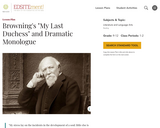
Reading Robert Browning's poem "My Last Duchess," students will explore the use of dramatic monologue as a poetic form, where the speaker often reveals far more than intended.
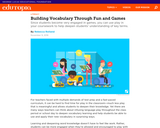
In these activities, students utilize play to refine and clarify vocabulary without feeling embarrassed or singled out in the classroom. Suggested methods include creating non-examples to show understanding; using online tools like Wordle or Visual Thesaurus; drawing pictures of unknown words; and using physical movement and a intensity rating scale to determine nuance and meaning.
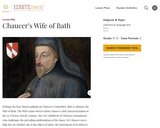
This lesson helps students understand the complexities of The Wife of Bath's character and the rhetoric of her argument by exploring the various ways in which Chaucer crafts a persona for her. After familiarizing themselves with the framing narrative of the Canterbury Tales and its language, students study the Wife of Bath as a character. Finally, students examine several primary source documents written about women and marraige in order to understand the context in which the Wife presents her argument.
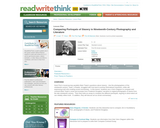
Like many 19th century photographers, Mark Twain struggled with how best to portray fictionalized characters while creating social commentary. In this lesson, students will compare and contrast Twain's novel and excerpts from Frederick Douglass' narrative to original photos of 19th century slaves. After writing journal entries about Huck Finn's Jim and Frederick Douglass, students write an essay evaluating the reliable depiction of slavery.

In this lesson students look critically at the story, "The Pit and the Pendulum" by Edgar Allen Poe. They use prediction strategies to form and refine thier opinions about the story line progression in each work. They read the story, screen the film, discuss reactions to both works, and plan and write a persuasive essay analyzing the validity of the film interpretation.
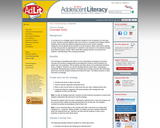
A concept sort is a strategy used to introduce students to the vocabulary of a new topic or book. Teachers provide students with a list of terms or concepts from reading material. Students place words into different categories based on each word's meaning. Categories can be defined by the teacher or by the students. When used before reading, concept sorts provide an opportunity for a teacher to see what his or her students already know about the given content. When used after reading, teachers can assess their students' understanding of the concepts presented.

Students will explore the connotations of the colors associated with the characters in F. Scott Fitzgerald's "The Great Gatsby." They will discuss the meaning of connotation and how word meanings can change. Next they will work in groups to explore the cultural connotations of a particular color, present findings to the class, keep a color log as they read the novel, and write an analysis of a major character.

This lesson plan is designed to help students understand the term connotation and how it applies to poetry. In this lesson, students are asked to practice using the term connotation with everyday words while working in small groups. From there, they will analyze one of American author Phyllis Wheatley's poems, which can be found at this address: http://rpo.library.utoronto.ca/poems/being-brought-africa-america .